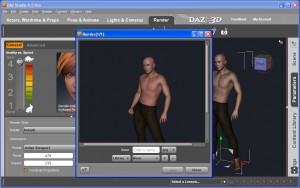Intro to 3D Toon Rendering: The Basics
September 15th, 2012 |Using 3D models with desktop rendering software opens up many possibilities to comic creators.
You could use them as references when drawing, like having a live model who can assume a pose and hold it indefinitely.
You can render the image and then either use it directly or do “post-work” effects to simulate drawing or painting.
Or you can use my preferred method, which is to use a toon “shader.” Basically, this means that the software that makes the image from the 3D models adds the lines and shading. I like this better than post-work because image filters have to guess where the edges of objects are, whereas the 3D render engine actually knows where the object boundaries are in the image.
Getting started with 3D art is very easy. I recommend DAZ Studio software (which is currently free) but there are plenty of other products, with varying feature sets.
The basic process consists of three steps:
- Load a model into the scene. This step is like having the actor step onto the stage.
- Pose the model. You can move each part into position manually, like arranging a mannequin, or you can load a pre-defined pose created by another artist.
- Render the scene. The software makes a 2D image from your 3D scene, like taking a snapshot of the stage.
Once you’ve mastered the basics, the possibilities are boundless. You can add more models, including clothes, furniture, backgrounds, etc. You can experiment with camera angles and lighting. And, most importantly, you can have fun!
Book recommendation: Figures, Characters and Avatars: The Official Guide to Using DAZ Studio to Create Beautiful Art- This book is a light introduction to the basics of 3D art, but the big value is the included software. The CD that accompanies the book has a good starting library: male and female figures and an assortment of accessories. Be aware that the figures (Michael 4 and Victoria 4) are not the latest generation – the fifth generation of these figures uses the new Genesis technology and M5/V5 accessories will not work with M4/V4. However, there are still many products available for M4/V4 and they are usually less expensive than the fifth generation products. Most of the characters in Rune: A Tale of Wizards and Kings use the M4 and V4 models.


